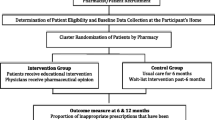Abstract
Objective: To determine the economic implications of sending an educational letter to patients, aimed at reducing long‐term BDZ prescribing.Method: Letters were sent to 242 patients from 2 general medical practices. BDZ usage and costs were compared in the years before and after intervention using numbers of defined daily dosages (DDDs) prescribed. The cost of intervention implementation was estimated using pharmacist, GP and administrative staff time, plus postage costs.Main outcome measures:Number of BDZ DDDs prescribed during the 12‐month periods before and after intervention. The cost implications of intervention.Results: Mean patient age was 67 years, 75% were female and the mean duration of BDZ usage was 19 years. A mean of 337 benzodiazepine DDDs per patient were prescribed during the baseline year. Overall BDZ usage at baseline was increasing by 13%. After receiving the letter, 31% of patients discussed BDZ usage with their GP and 10% had their drug or strength changed. During the year after intervention, a significant reduction of 17% in benzodiazepine usage was observed compared to baseline; 5% of patients ordered no more benzodiazepine prescriptions after receiving the letter.Mean BDZ costs reduced by £1.20 per patient after intervention. The cost of intervention implementation was £5.54 per patient, giving a net cost of £4.34 per patient, or £86.80 to obtain one BDZ discontinuation.Conclusion: This intervention is effective, simple, and inexpensive. Its minimal cost could be justified given the morbidity associated with the long‐term prescribing of benzodiazepines, particularly in the elderly.
Similar content being viewed by others
References
Marriott S, Tyrer P. Benzodiazepine dependence: avoidance and withdrawal. Drug Safety 1993;9(2):93-103.
Tyrer P, Owen R, Dawling S. Gradual withdrawal of diazepam after long-term therapy. Lancet 1983;ii:1402-6.
Tyrer P, Murphy S. The place of benzodiazepines in psychiatric practice. Br J Psychiatry 1987;151:719-23.
British Medical Association & Royal Pharmaceutical Society of Great Britain. British National Formulary. Number 35 (March 1998) London: BMA & RPSGB, 1998.
Leipzig RM, Cumming RG, Tinetti ME. Drugs and falls in older people: A systematic review and meta-analysis: I. Psychotropic drugs. J Am Geriatr Soc 1999;47:30-9.
Committee on the Review of Medicines. Systematic review of the benzodiazepines. BMJ 1980;280:910-2.
Einarson TR. Drug-related hospital admissions. Ann Pharmacother 1993;27:832-9.
Cunningham G, Dodd TRP, Grant DJ, McMurdo MET, Richards RME. Drug-related problems in elderly patients admitted to Tayside hospitals, methods for prevention and subsequent reassessment. Age Ageing 1997;26:375-82.
Hurwitz N. Admissions to hospital due to drugs. BMJ 1969;1:539-40.
Barbone F, McMahon AD, Davey PG, Morris AD, Reid IC, McDevitt DG, MacDonald TM. Association of road-traffic accidents with benzodiazepine use. Lancet 1998;352:1331-6.
Department of Health. Prescription cost analysis data: England 1999. London: DoH, 2000.
Barter G, Cormack M. The long-term use of benzodiazepines: patients' views, accounts and experiences. Fam Pract 1996;13:491-7.
King MB, Gabe J, Williams P, Rodrigo EK. Long term use of benzodiazepines: the views of patients. Br J Gen Pract 1990;40:194-6.
Wright N, Caplan R, Payne S. Community survey of long term daytime use of benzodiazepines. BMJ 1994;309:27-8.
Cormack MA, Sweeney KG, Hughes-Jones H, Foot GA. Evaluation of an easy, cost-effective strategy for cutting benzodiazepine use in general practice. Br J Gen Pract 1994;44:5-8.
World Health Organisation. Anatomical Therapeutic Chemical (ATC) classifiscation index including Defined Daily Doses (DDDs) for plain substances. Oslo: WHO Collaborating Centre for Drug Statistics Methodology, 1997.
Edwards JG, Cantopher T, Oliveri S. Medicolegal aspects of benzodiazepine dependence: Duties and responsibilities of doctors. Med J Aust 1992;156:733-7.
Department of Health. The new NHS: modern, dependable. London: DoH, 1997.
Department of Health. The NHS plan: a plan for investment, a plan for reform. London: DoH, 2000.
Department of Health. Statistics of prescriptions dispensed in the community: England 1988 to 1998. London: DoH, 1999.
Author information
Authors and Affiliations
Corresponding author
Rights and permissions
About this article
Cite this article
Morgan, J.D., Wright, D.J. & Chrystyn, H. Pharmacoeconomic evaluation of a patient education letter aimed at reducing long-term prescribing of benzodiazepines. Pharm World Sci 24, 231–235 (2002). https://doi.org/10.1023/A:1021587209529
Issue Date:
DOI: https://doi.org/10.1023/A:1021587209529




